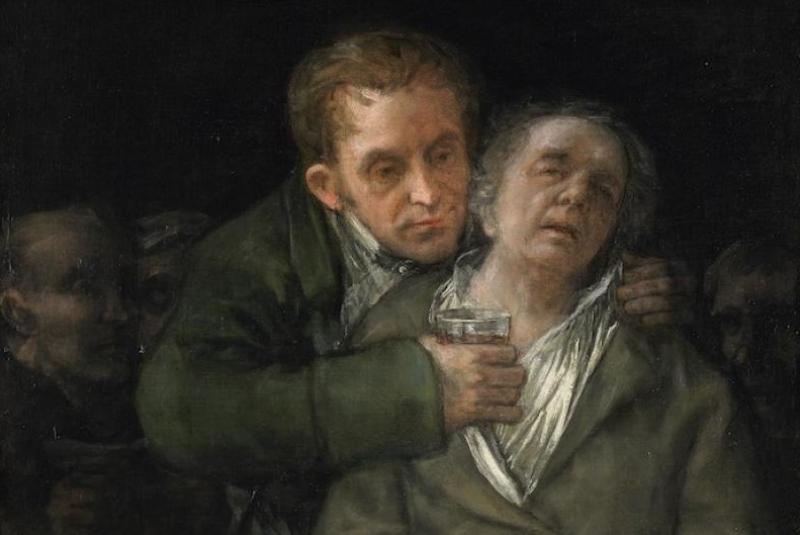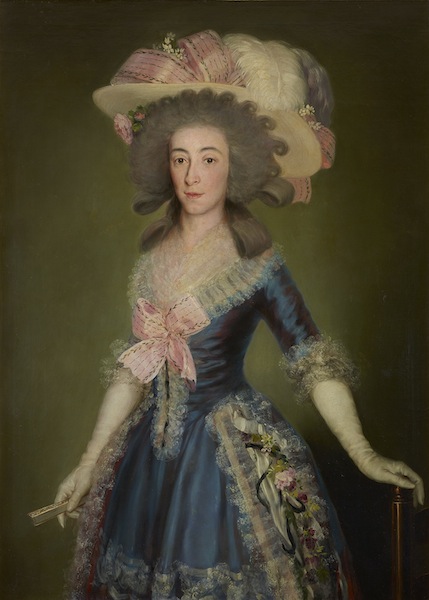Goya: The Portraits, National Gallery | reviews, news & interviews
Goya: The Portraits, National Gallery
Goya: The Portraits, National Gallery
So much drama and emotion - an exhibition that pulses with life

The brute nature of man in times of war, religious persecution and hypocrisy, and the destructive power of superstition. Francisco de Goya’s fame today largely rests on such themes, and they go a long way to explain just why he’s often considered the first modern artist.
But Goya was also a remarkable portraitist, an official painter to the Spanish court, and one of art's great sensualists. And though we don’t have the famous nude and clothed Maja, which hang side-by-side in the Prado, the National Gallery’s thrillingly seductive exhibition attests to his renown as a master of the portrait – though not one who was without faults.
What, for instance, is happening with the alarmingly truncated legs of Francisco de Saavedra, the soberly handsome finance minister who sits contemplatively at his desk? Painted in 1798, recent technical examination shows that the finely painted head came first, with the rest of the body painted later at speed. Those lower limbs, affixed to that overlong torso, certainly seem to have come as an afterthought.
Goya’s legs and arms do occasionally go awry, and his sitters sometimes resemble little more than enchanting dolls. The Duke and Duchess of Osuna and their Children, 1788, is a clear case in point. With its finely dressed figures as stiff as painted wooden puppets, this otherwise affectionate family portrait hardly attests to his great skills of psychological penetration.
But when Goya is good he is often great, and these qualms only highlight that genius – an unfashionable word and an old-fashioned concept, for sure – though instinctive, still has to be worked at; since there is no formula, to rise to the challenge of its demands is risky. And technical perfection, although there is plenty of that here – just look at the exquisite dress, with its laces, bows, floral embellishments, of the gimlet-eyed Countess-Duchess of Benavente (pictured below; 1785; Private Collection © Joaquín Cortés) – can’t lend a work of art energy. This exhibition is so full of energy that it bristles and crackles with life.
 This leads us to the thing that makes so many of these portraits appear so very modern. Often they’re like snapshots. Faces betray hilarity, surprise, intrigue, each suggesting a fleeting moment. Often the subject appears as if caught unawares; sometimes as if they are about to speak. Words appear to be forming in the mouth of the bewigged Juan de Villanuevea; a passing cloud of consternation troubles the pale complexion of Juan Antonio Meléndex Valdés; and one hearty gentleman in the dynamic group portrait The Family of the Infante Don Luis de Bourbon, 1783-4, positively beams with amusement at the viewer, his arresting gaze lusty and penetrating. How often do we get to see wide grins in a formal portrait? Well, Goya achieves them with all the virtuosic naturalness that makes the scene convincing and animated. There are no ghastly rictus grimace-grins here.
This leads us to the thing that makes so many of these portraits appear so very modern. Often they’re like snapshots. Faces betray hilarity, surprise, intrigue, each suggesting a fleeting moment. Often the subject appears as if caught unawares; sometimes as if they are about to speak. Words appear to be forming in the mouth of the bewigged Juan de Villanuevea; a passing cloud of consternation troubles the pale complexion of Juan Antonio Meléndex Valdés; and one hearty gentleman in the dynamic group portrait The Family of the Infante Don Luis de Bourbon, 1783-4, positively beams with amusement at the viewer, his arresting gaze lusty and penetrating. How often do we get to see wide grins in a formal portrait? Well, Goya achieves them with all the virtuosic naturalness that makes the scene convincing and animated. There are no ghastly rictus grimace-grins here.
And then there are the self-portraits, ranging from the youthfully pudgy-faced to old age and, literally, near death. The rarely loaned Self-Portrait with Doctor Arrieta, 1820 (main picture), from the Minneapolis Institute of Art, shows the artist barely conscious, in the grip of an unknown malady (a serious illness, whose cause was also unknown, had left him profoundly deaf almost 30 years earlier). He clutches at his bedspread as the doctor attempts to administer some potion or reviving beverage. Faces – priests or demons, perhaps figments conjured by Goya’s delirium – haunt the shadows. Dr Arrieta is Goya’s friend and saviour and the painting is gifted to him – a dedication appears at the bottom of the canvas – yet he, too, looks sinister.
There is so much life, drama and emotion here, among the 70-odd portraits in this tremendous exhibition. This is what makes Goya great, and it’s also what makes him feel so much our contemporary.
Share this article
Add comment
The future of Arts Journalism
You can stop theartsdesk.com closing!
We urgently need financing to survive. Our fundraising drive has thus far raised £49,000 but we need to reach £100,000 or we will be forced to close. Please contribute here: https://gofund.me/c3f6033d
And if you can forward this information to anyone who might assist, we’d be grateful.

Subscribe to theartsdesk.com
Thank you for continuing to read our work on theartsdesk.com. For unlimited access to every article in its entirety, including our archive of more than 15,000 pieces, we're asking for £5 per month or £40 per year. We feel it's a very good deal, and hope you do too.
To take a subscription now simply click here.
And if you're looking for that extra gift for a friend or family member, why not treat them to a theartsdesk.com gift subscription?
more Visual arts
 'We are bowled over!' Thank you for your messages of love and support
Much-appreciated words of commendation from readers and the cultural community
'We are bowled over!' Thank you for your messages of love and support
Much-appreciated words of commendation from readers and the cultural community
 Lee Miller, Tate Britain review - an extraordinary career that remains an enigma
Fashion photographer, artist or war reporter; will the real Lee Miller please step forward?
Lee Miller, Tate Britain review - an extraordinary career that remains an enigma
Fashion photographer, artist or war reporter; will the real Lee Miller please step forward?
 Kerry James Marshall: The Histories, Royal Academy review - a triumphant celebration of blackness
Room after room of glorious paintings
Kerry James Marshall: The Histories, Royal Academy review - a triumphant celebration of blackness
Room after room of glorious paintings
 Folkestone Triennial 2025 - landscape, seascape, art lovers' escape
Locally rooted festival brings home many but not all global concerns
Folkestone Triennial 2025 - landscape, seascape, art lovers' escape
Locally rooted festival brings home many but not all global concerns
 Sir Brian Clarke (1953-2025) - a personal tribute
Remembering an artist with a gift for the transcendent
Sir Brian Clarke (1953-2025) - a personal tribute
Remembering an artist with a gift for the transcendent
 Emily Kam Kngwarray, Tate Modern review - glimpses of another world
Pictures that are an affirmation of belonging
Emily Kam Kngwarray, Tate Modern review - glimpses of another world
Pictures that are an affirmation of belonging
 Kiefer / Van Gogh, Royal Academy review - a pairing of opposites
Small scale intensity meets large scale melodrama
Kiefer / Van Gogh, Royal Academy review - a pairing of opposites
Small scale intensity meets large scale melodrama
 Jenny Saville: The Anatomy of Painting, National Portrait Gallery review - a protégé losing her way
A brilliant painter in search of a worthwhile subject
Jenny Saville: The Anatomy of Painting, National Portrait Gallery review - a protégé losing her way
A brilliant painter in search of a worthwhile subject
 Abstract Erotic, Courtauld Gallery review - sculpture that is sensuous, funny and subversive
Testing the boundaries of good taste, and winning
Abstract Erotic, Courtauld Gallery review - sculpture that is sensuous, funny and subversive
Testing the boundaries of good taste, and winning
 Edward Burra, Tate Britain review - watercolour made mainstream
Social satire with a nasty bite
Edward Burra, Tate Britain review - watercolour made mainstream
Social satire with a nasty bite
 Ithell Colquhoun, Tate Britain review - revelations of a weird and wonderful world
Emanations from the unconscious
Ithell Colquhoun, Tate Britain review - revelations of a weird and wonderful world
Emanations from the unconscious
 Rachel Jones: Gated Canyons, Dulwich Picture Gallery review - teeth with a real bite
Mouths have never looked so good
Rachel Jones: Gated Canyons, Dulwich Picture Gallery review - teeth with a real bite
Mouths have never looked so good

Comments
Great stuff. Only saw the